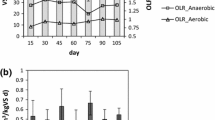Summary
A mathematical model for a total organic carbon-monitored, completely mixed activated sludge process for the treatment of a mixed domestic and laboratory waste water is discussed and experimentally calibrated. The first-order kinetic model was better suited to fit the experimental data than the Monod model. Values obtained for the sludge yield, Y, and the first-order kinetic constant, kL, agree with analogous data calculated from the literature. Hence, total organic carbon can be used, exclusively, to measure both organic waste load and biological solids, as an advantageous alternative to either biological oxygen demand, chemical oxygen demand, or volatile suspended solids, in monitoring, in deriving operational conditions, and/or in quantifying a mathematical description of a waste-water treatment process.
Similar content being viewed by others
Abbreviations
- b:
-
specific mortality coefficient (d−1)
- BOD:
-
biological oxygen demand (mg O2×l −1)
- BOD5 :
-
5-day BOD
- COD:
-
chemical oxygen demand (mg O2×l −1)
- d:
-
day
- ke :
-
experimental constant for settling velocity (l×mg−1)
- kL :
-
aggregate first-order kinetic constant = µmaxxKm -1 xY -1(l x mg-1 x d-1)
- Km:
-
Michaelis-Menten saturation coefficient (mg×l −1)
- Lb :
-
concentration of biodegradable organic load (mg×l −1)
- Lnb :
-
concentration of nonbiodegradable oragnic load (mg×l −1)
- Ms :
-
concentration of suspended solids (mg×l −1)
- Q:
-
flow rate (l×h−1)
- SS:
-
suspended solids (mg×l −1)
- SVI:
-
sludge volume index (ml×g−1)
- T:
-
temperature (°C)
- t:
-
time (h or d)
- TOC:
-
total organic carbon (mg C×l −1)
- U:
-
specific substrate elimination rate (d−1)
- V:
-
aeration tank volume (l)
- v:
-
settling velocity (m×h−1)
- vo :
-
experimental constant for settling velocity (m×h−1)
- VSS:
-
volatile suspended solids (mg×l −1)
- Y:
-
sludge yield (biomass produced per unit substrate removed)
- γ:
-
thickening factor of the settler
- ζ:
-
part of suspended solids remaining in outflow
- η:
-
ratio between the hydraulic and sludge retention times
- θ:
-
hydraulic retention time (h)
- θ :
-
sludge retention time (d)
- θ s :
-
maximum specific growth rate (d−1)
- π:
-
wasting ratio
- ρ:
-
recycle ratio
- b:
-
biodegradable
- e:
-
eliminated
- nb:
-
nonbiodegradable
- r:
-
plant outflow
- Ro :
-
waste
- R2 :
-
recycle
- S:
-
soluble
- susp:
-
suspended
- T:
-
total
- 1:
-
inflow
- 3:
-
acrator outflow
References
Adams, C.E., Eckenfelder, W.W., Jr., Hovious, J.C. (1975). Water Res. 9, 37–42
Busch, A.W. (1965). Proc. 20th Ind. Waste Conf., Eng. Bull. Purdue Univ., Extension Series No. 118, 457–469
Busch, A.W. (1966). Water Resour. Res. 2, 59–69
Chandler, R.L., O'Shaughnessy, J.C., Blanc, F.C. (1976). J. Water Pollut. Control Fed. 48, 2791–2803
Chiu, S.Y., Erickson, L.E., Fan, L.T., Kao, I.C. (1972). Biotechnol. Bioeng. 14, 207–231
Eckenfelder, W.W., Jr. (1967). J. Sanit. Eng. Div. Am. Soc. Civ. Eng. 93, 157–170
Elmaleh, J., Ben Aim, R. (1976). Water Res. 10, 1005–1009
Emery, R.M., Welch, E.B., Christman, R.F. (1971). J. Water Pollut. Control. Fed. 43, 1834–1844
Ford, D.L. (1968). Proc. 23rd Ind. Waste Conf., Eng. Bull. Purdue Univ., Extension Series No. 132, 989–999
Gaudy, A.F., Jr., Srinivasaraghaven, R. (1974). Biotechnol. Bioeng. 16, 723–738
Goodman, B.L., Englande, A.J. Jr. (1974). J. Water Pollut. Control Fed. 46, 312–332
Johnston, M.B. (1974). Environ. Pollut. Management 4, No. 1
Jones, R.H. (1972). Water Wastes Eng. 9, 32–33
Lamb, A., Tollefson, E.L. (1972). Canad. J. Chem. Eng. 50, 173–178
Leithe, W. (1971). Chem. Ztg. 95, 465
Loudenot, M. (1973). Technique Eau Assainissement 314, 19–27
Masselli, J.W., Masselli, N.W., Burford, M.G. (1972). Text. Industries 136, 53–60
Maier, W.J., McConnell, H.L. (1974). J. Water Pollut. Control Fed. 46, 623–633
McKinney, R.E. (1974). Biotechnol. Bioeng. 16, 703–722
McKinney, R.E., Ooten, R.J. (1969). Trans. 19th Ann. Conf. Sanitary Eng., R.E. McKinney, ed., Bull. Eng. Architecture, No. 60, 32–59
Mynhier, M.D., Grady, C.P.L., Jr. (1975). J. Environ. Eng. Div., Am. Soc. Civ. Eng. 101, 829–846
Schaffer, R.B., Van Hall, C.E., McDermont, G.N., Barth, D., Stenger, V.A., Sebesta, S.J., Griggs, S.H. (1965). J. Water Pollut. Control Fed. 37, 1545–1566
Schroeder, E.D. (1971). Water Res. 5, 29–39
Tyteca, D., Smeers, Y., Nyns, E.J. (1977). C.R.C. Crit. Rev. Environ. Control 8, 1–89
Author information
Authors and Affiliations
Additional information
This work was supported by grants from the Fonds de Développement Scientifique and the Commission du Tiers-Monde of the University of Louvain
Rights and permissions
About this article
Cite this article
Rao, C.U., Tyteca, D. & Nyns, E.J. Total organic carbon-calibrated mathematical model for a completely mixed activated sludge waste-water treatment process. European J. Appl. Microbiol. Biotechnol. 6, 1–12 (1978). https://doi.org/10.1007/BF00500851
Received:
Issue Date:
DOI: https://doi.org/10.1007/BF00500851




